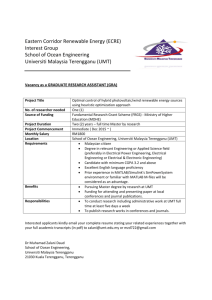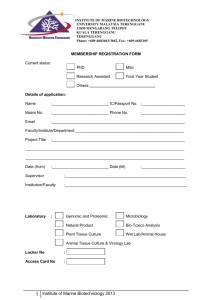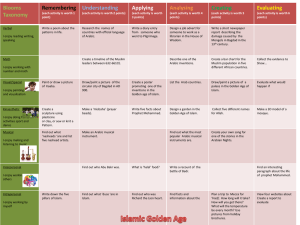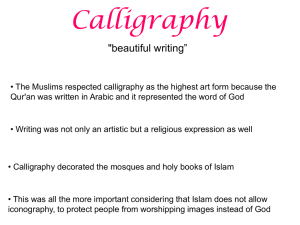Use of Arabic Language in Terengganu in the Early 20 Century
advertisement
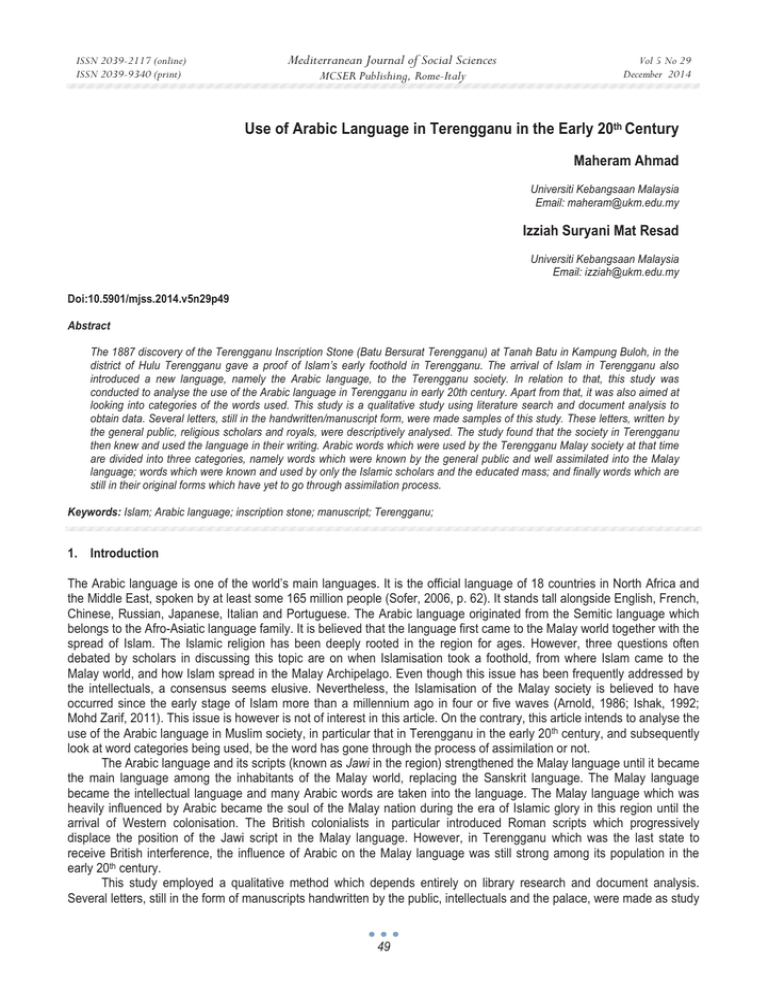
ISSN 2039-2117 (online) ISSN 2039-9340 (print) Mediterranean Journal of Social Sciences MCSER Publishing, Rome-Italy Vol 5 No 29 December 2014 Use of Arabic Language in Terengganu in the Early 20th Century Maheram Ahmad Universiti Kebangsaan Malaysia Email: maheram@ukm.edu.my Izziah Suryani Mat Resad Universiti Kebangsaan Malaysia Email: izziah@ukm.edu.my Doi:10.5901/mjss.2014.v5n29p49 Abstract The 1887 discovery of the Terengganu Inscription Stone (Batu Bersurat Terengganu) at Tanah Batu in Kampung Buloh, in the district of Hulu Terengganu gave a proof of Islam’s early foothold in Terengganu. The arrival of Islam in Terengganu also introduced a new language, namely the Arabic language, to the Terengganu society. In relation to that, this study was conducted to analyse the use of the Arabic language in Terengganu in early 20th century. Apart from that, it was also aimed at looking into categories of the words used. This study is a qualitative study using literature search and document analysis to obtain data. Several letters, still in the handwritten/manuscript form, were made samples of this study. These letters, written by the general public, religious scholars and royals, were descriptively analysed. The study found that the society in Terengganu then knew and used the language in their writing. Arabic words which were used by the Terengganu Malay society at that time are divided into three categories, namely words which were known by the general public and well assimilated into the Malay language; words which were known and used by only the Islamic scholars and the educated mass; and finally words which are still in their original forms which have yet to go through assimilation process. Keywords: Islam; Arabic language; inscription stone; manuscript; Terengganu; 1. Introduction The Arabic language is one of the world’s main languages. It is the official language of 18 countries in North Africa and the Middle East, spoken by at least some 165 million people (Sofer, 2006, p. 62). It stands tall alongside English, French, Chinese, Russian, Japanese, Italian and Portuguese. The Arabic language originated from the Semitic language which belongs to the Afro-Asiatic language family. It is believed that the language first came to the Malay world together with the spread of Islam. The Islamic religion has been deeply rooted in the region for ages. However, three questions often debated by scholars in discussing this topic are on when Islamisation took a foothold, from where Islam came to the Malay world, and how Islam spread in the Malay Archipelago. Even though this issue has been frequently addressed by the intellectuals, a consensus seems elusive. Nevertheless, the Islamisation of the Malay society is believed to have occurred since the early stage of Islam more than a millennium ago in four or five waves (Arnold, 1986; Ishak, 1992; Mohd Zarif, 2011). This issue is however is not of interest in this article. On the contrary, this article intends to analyse the use of the Arabic language in Muslim society, in particular that in Terengganu in the early 20th century, and subsequently look at word categories being used, be the word has gone through the process of assimilation or not. The Arabic language and its scripts (known as Jawi in the region) strengthened the Malay language until it became the main language among the inhabitants of the Malay world, replacing the Sanskrit language. The Malay language became the intellectual language and many Arabic words are taken into the language. The Malay language which was heavily influenced by Arabic became the soul of the Malay nation during the era of Islamic glory in this region until the arrival of Western colonisation. The British colonialists in particular introduced Roman scripts which progressively displace the position of the Jawi script in the Malay language. However, in Terengganu which was the last state to receive British interference, the influence of Arabic on the Malay language was still strong among its population in the early 20th century. This study employed a qualitative method which depends entirely on library research and document analysis. Several letters, still in the form of manuscripts handwritten by the public, intellectuals and the palace, were made as study 49 ISSN 2039-2117 (online) ISSN 2039-9340 (print) Mediterranean Journal of Social Sciences MCSER Publishing, Rome-Italy Vol 5 No 29 December 2014 samples. Those letters were descriptively analysed. 2. Islam’s Entry into Terengganu The discovery of the Terengganu Inscription Stone in 1887 at Tanah Batu, Kampung Buloh, in the district of Hulu Terengganu provided a proof of early foothold of Islam in Terengganu. Much has been done to comprehend the inscription on the stone (Memorial Batu Bersurat, 1992). A research by C.O. Blagden published in JMBRAS 1924 was among the earliest studies and almost all studies since then were based on the work of Blagden (Blagden, 1924). The content of the Terengganu Inscription Stone was an important note containing information on Islamic governance, namely Mandalika Islam in the state of Terengganu in the 14th century A.D. (Awang, 1983). Syed Muhammad Naqiub al-Attas concluded that the date inscribed on the Terengganu Inscription Stone was Friday, 4th of Rajab 702A.H. or equivalent to 22nd of February 1303A.D. (al-Attas, 1970). The first page of the Terengganu Inscription Stone contained a declaration which required the ruler and the nobles of the state to uphold Islamic teaching brought by the Prophet Muhammad p.b.u.h, while the other three surfaces of the stone contained nine or ten provisions of the laws declared as the state law by the Ruler of Terengganu (Petersons, 1924; Fatimi, 1970). Some researchers concluded that the laws as inscribed on the stone were not purely Islamic laws but they were laws which were influenced by the local Malay customs and contemporary Javanese law. Many Javanese and Sanskrit terms were used on the inscription stone (Mohd Yatim & Nasir, 1990; Blagden, 1924). The Jawi scripts carved on the Terengganu Inscription Stone was a proclamation of the Islamic law as the State Law of Terengganu and this proved that Islam had spread to the region (Bladgen, 1924). Peterson opined that the proclamation was a law for the newly professed religion of the society which was written in the language or terms of the Hindu religion which was understood by the locals. There were 29 Sanskrit terms and 10 words in the Arabic language (Petersons, 1924). The discovery proved that the religion of Islam has a long history in in Terengganu. The existence of a Malay government which was premised on the religion and laws of Islam in a district far away from the shore or estuary was something often questioned by local and foreign historians. A point of confusion is that Terengganu is not located on the West Coast which fronts Sumatera which in turn received Islam earlier and was a trade route to India and the West (Fatimi, 1963). However, the choice of location was probably made as an alternative to avoid the risk of foreign attacks (Mohd Yatim & Nasir, 1990). The existence of the inscription was proof to the fact that Terengganu residents had embraced Islam long before the date inscribed on the Terengganu Inscription Stone which was 702A.H./1303A.D. 3. Background of Terengganu Population in the Early 20th Century A.D. The State of Terengganu is a state in Malaysia. The state is located on the East Coast of the Malay Peninsula. In the early 20th century AD, the state of Terengganu was among the few states which could maintain its independence from British and Siamese domination. Wisdom of her Ruler and prosperity of the state were the reasons why the state was free from influence of any power. At that time, the state was ruled by Sultan Zainal Abidin III. Its population reached about 100 000 people, 40% more than the population of the state of Pahang (Adil, 1982). Census made in the month of March 1911 showed that the amount of population increased to 154 073 people including 4704 non-Muslim residents (Abdullah Alwi, 1991). Terengganu residents were portrayed as the strongest Malay community to hold to religion compared to the Malay population of other Malay states. The ulema (Islamic scholars) of Terengganu successfully made Terengganu population realize the importance of seeking religious knowledge. A scholarly figure most influential at that time was Sayyid Abdul Rahman al-Idrus or more famously known as Tok Ku Paloh. Hundreds of people followed his sermons which were delivered weekly. Not only did he assert a huge influence among the people but also he was a teacher to Sultan Zainal Abidin III. This Sultan of Terengganu was considered by British officials as different from other Malay Rulers. The Ruler of Terengganu was viewed as a pious man and knowledgeable in religious matters (Clifford, 1992). Under his rule, religious education development was given attention by the ulema. Islamic education in Terengganu was far more advanced compared to those of other Malay states (The Annual Report of the British Agent Terengganu, 1915). The advancement of Islamic knowledge is closely related to the spread of Arabic language use among the masses since the source of Islamic knowledge is in the language. Furthermore, most of the Islamic scholars in Terengganu received their education in the Middle East. Tok Ku Paloh himself spent approximately ten years studying religious knowledge in Mecca (Said, 1998). Undeniably, Islam gave a fresh breath of air to the Malay language and the Arabic language has a huge influence in enriching the vocabulary of the Malay language. 50 ISSN 2039-2117 (online) ISSN 2039-9340 (print) Mediterranean Journal of Social Sciences MCSER Publishing, Rome-Italy Vol 5 No 29 December 2014 4. The Use of Arabic Language among Terengganu Population Terengganu residents were late to receive British influence because the Western power interfered in the state governance only after the 1909 Bangkok Treatise. This situation more or less had an impact onto the Malay language spoken by its residents due to less foreign influence among them. The influence of Arabic among the population can be categorized into three. First, they are Arabic words which are preserved due to either they are not understood or difficult to translate into Malay or there is no other Arabic word generally understood by the Malays. Second are Arabic words which are only understood by the educated and the scholars and third are Arabic words which had been assimilated into the Malay language (al-Attas, 1988). 5. The General Public Arabic words used by the general public of Terengganu were found to be words which were readily understood by the society. This type of words can be clearly seen in statements and letters by Terengganu residents on the 1928 farmers uprising in Kuala Berang. In a written statement of Muhammad Qasim bin Husain at Istana Maziah, Arabic words used were words commonly accepted and known by the general public such as zuhur, isnin, haji, jumaat, selasa, hakim (Suk. Tr., 1346a). The same goes with Arabic words used in the letter of Penghulu Mukim Jerung to the State Government Secretary of Terengganu which were hormat, isnin, sebab, takzim, faham, maklum and tarikh (Suk. Tr., 1346b). Meanwhile, in a letter of Penghulu Bukit Payong, Arabic words used were terms generally accepted among the Malay community such as maklum, faham, tarikh, aman and taat. However, there was usage of the word qidam (Suk. Tr., 1346) which was rarely used. In a letter from Penghulu Ajil to the Terengganu State Secretary, used Arabic words were those which were well-integrated with the life of the Malay community namely hormat, tarikh, surat, Zulhijjah, faham and insya Allah (Suk. Tr., 1346c). However, among the more educated mass, there were more usage of Arabic words. An example can be seen in a letter from Muhammad Yusuf bin Haji Tahir who was studying at a madrasah by the name Pondok Haji Mat Shafie Kampung Losong, Terengganu to Sultan Sulaiman Badrul Alam Shah. Arabic words which were used showed that he was exposed to the Arabic language while studying in Kelantan and Terengganu. Apart from using readily accepted and understood Arabic words such as makmur, maklum, daif, kalam and takzim, he also used words or phrases which were only understood by the educated among the public. The following are examples of the phrases: zalallah fil-alam, khalifat al-mu’minin min bani Adam, al-masyhur fi al-bilad al-`arab wa al-`ajam, fi al-daraiyn al-dunya wa al-akhirah, bi ‘awn Allah al-‘aziz al-karim, bi taqdirih ‘azza wa jall and tadbir ya ahl al-wilayah (S.T., 1348). 6. Islamic Scholars Many among Terengganu Islamic scholars studied in Mecca. They were found to be more influenced by the use of Arabic language as compared to the common public. Arabic was found to be much used in their interaction among each other. An example is the use of the language in Tok Ku Paloh’s letter to Sultan Zainal Abidin III. Tok Ku Paloh once studied in an Arabic state while Sultan Zainal Abidin III was also conversant in Arabic and his Arabic teacher was Habib Umar (Adil, 1982). In the letter sent by this scholar to His Majesty Sultan, use of Arabic was evident. Should someone who did not know Arabic were to read the letter, he would find it difficult to understand. Arabic words used were of original and pure Arabic language such as ahl al-nazar wa al-basirah, milal, muhit, mi’ad, majma’ al-bahrayn, ma’ash; khulafa’, rashidin, wasitah, bashariyyah, kulli, qit’an, bab Allah al-a’zam, mahmud, bi talaqqi min Allah al-wahy wa bi quwwat albashariyyah, yulqihi ilayna, and rusul ‘alayhi al-salat wa al-salam (Hashim, 1991). Furthermore, he also used Arabic words commonly used and understood by fairly educated commoner such as muslimin, mu’amalah, dunyawi, subhanah wa ta’ala, ukhrawiyyah, and anbiya’. He also used many Arabic words typically used in the Malay language such as ahwal, hakiki, iktikad, akal, dunia, syarak, wajib, imam, maslahah, hikmah, akhirat and Islam (Hashim, 1991). Nevertheless, Arabic word usage also depends on at whom the words were directed. When the scholars interacted with a commoner, the Arabic language used was that which had been ‘Malayised’ or assimilated into the Malay language. Nevertheless, there had been usage of Arabic words which were rarely used. An example of the use of Arabic language by a scholar to the common public is a letter from Haji Abdul Rahman Limbung to the Terengganu Commissioner of Lands and Mines. The Arabic words used in the letter were those readily understood by the masses such as faham, hak, sebab, asal, sultan, adat, batal, sah, hukum, mahsul, taat and maklum, but there were also words which were rarely used and only understood by the educated ones such as madhkur (Suk. Tr., 599/1342). 51 ISSN 2039-2117 (online) ISSN 2039-9340 (print) Mediterranean Journal of Social Sciences MCSER Publishing, Rome-Italy Vol 5 No 29 December 2014 7. The Nobles/Palace Sultan Zainal Abidin III was the Terengganu ruler until 1918. He was known for his piety, deep knowledge of the religion and good command of Arabic (Adil, 1982), Arabic language influence can be seen in his letter to the British High Commissioner Sir Arthur Young dated 1344AD. His Majesty was found to use Arabic words understood by the public such as alim, surat, tarikh, faham, syarat, maklum, ikhtiar, maksud, and ahwal. Even though the letter was meant for a British official, His Majesty used Arabic words which were only known by the learned such as the words maktub, wasal, dar al-ma’mur wa al-masyhur and madhkur (S.T., 1344a). Arabic words usage among the nobles can also be seen in a letter written by a female relative of Sultan Sulaiman Badrul Alam Shah, Tengku Nik Maimunah Bt Sultan Zainal Abidin III to His Majesty. She was found to have used Arabic language which was only understood by the educated such as hafizahullah ta’ala fi al-darayn. In addition to this, she used the words thabit, amin, maklum, tarikh, al-marhum, mahkamah, sya’ban, Zulqai’dah, hak, jaqab, zalim and adil (S.T., 1344b). 8. Conclusion The usage of Arabic words among Terengganu residents in the early 20th century was found to be influenced by individual educational background and to whom the words were directed. Among the educated and the intellectuals or scholars, Arabic words usage was found to be more widespread. They were using not only Arabic words which had become parts of the Malay vocabulary but also Arabic terms which were only understood by those who learnt Arabic and rarely used by the public. The public meanwhile were found to use Arabic words commonly used in daily life, words usually associated with worship or religious rituals or Arabic words which were well used by the public or loanwords from the Arabic language which had been well-incorporated into the Malay language or ‘Malayised’. 9. Acknowledgement This study is financed by the Research Group of Arabic Culture and Islamic Civilization (KUKAPI, DPP-2014-068), UKM; the Action/Strategic Research Project (PTS-2012-061; PTS-2014-068), UKM; the University-Industry Incentive Grant (INDUSTRI-2012-006), UKM; and the Arus Perdana Project (AP-2012-001; AP-2013-017; AP-2014-006), UKM. References Adil, Buyong. (1982). Sejarah Terengganu (Terengganu History). Kuala Lumpur: Dewan Bahasa & Pustaka. Arnold, Thomas W. (1986). The Preaching of Islam. London: Darf Publishers Ltd. al-Attas, Syed Muhammad Naquib. (1970). The Correct Date of Terengganu Inscriptions. Kuala Lumpur: Muzium Negara.Awang, Muhammad Saleh. (1983). Sejarah Darul Iman Hingga 1337H=1918M (The History of Darul Iman until 1337 AH1918 AD). Kuala Lumpur: Utusan Publications & Distributors Sdn.Bhd. Bladgen, C.O. (1924). A Note on the Terengganu Inscription. JMBRAS, III(3), 252-258. Clifford, H. 1992. Report of an Expedition into Trengganu and Kelantan in 1895. Kuala Lumpur: The Malayan Branch of Royal Asiatic Society. Hashim, Muhammad Yusoff. (1991). Terengganu Darul Iman: Tradisi Persejarahan Malaysia (Terengganu Darul Iman: A Tradition of Malaysian Historicity). Kuala Lumpur: Dewan Bahasa & Pustaka. Ishak, Abdullah. (1992). Islam di Nusantara (Khususnya di Tanah Melayu) (Islam in the Malay Archipelago (Particularly in The Malay Land)). Kuala Lumpur: Bahagian Hal Ehwal Islam, Jabatan Perdana Menteri. Memorial Batu Bersurat. 1922. Kuala Terengganu: Muzium Negeri Terengganu. Mohd Yatim, Othman & Nasir, Abdul Halim. (1990). Epigrafi Islam Terawal di Nusantara (Early Islamic Epigraphy in the Malay Archipelago). Kuala Lumpur: Dewan Bahasa & Pustaka. Mohd Zarif, Muhammad Mustaqim. (2011, 9-11 June). Satu milenium Islam di nusantara: Tinjauan sosio-sejarah (A millennium of Islam in the malay archipelago: A socio-historical survey). Paper presented in Konvensyen Wasatiyyah Sempena 1 Milenium Islam di Nusantara (Wasatiyyah Convention in conjunction with 1Millennium of Islam in the Malay Archipelago). Putrajaya: Universiti Sains Islam Malaysia and Nadi Dialog (NADI) in cooperation with JAKIM, 1-19. Petersons, H.S. (1924). An early Malay inscription from Terengganu. JMBRAS, III(3), 258-263. S.T. (1344a, No. 2). Meminjam Seorang Inggeris Tuan Maxwell menjadi ahli Mesyuarat Negeri Terengganu dan ganti Tuan Hampres Mahkamah Jawatan British Agen Terengganu. Surat Sultan Zainal Abidin III kepada Pesuruhjaya Tinggi British Sir Athur Young (Letter of Sultan Zainal Abidin III to the British High Commissioner Sir Arthur Young), Muharam 7. S.T. (1344b, No. 107). Berkenaan dengan Tanah di dalam Telemong (On Land in Telemong). Surat Tengku Nik Maimunah bt Sultan Zainal Abidin III kepada Sultan Sulaiman Badrul Alam Shah (Letter of Tengku Nik Maimunah Bt Sultan Zainal Abidin III to Sultan Sulaiman Badrul Alam Shah), Sha‘ban 28. 52 ISSN 2039-2117 (online) ISSN 2039-9340 (print) Mediterranean Journal of Social Sciences MCSER Publishing, Rome-Italy Vol 5 No 29 December 2014 S.T. (1348, No. 61). Memohon Ampun di atas Bapanya Haji Tahir (Request for Pardon for his Father, Haji Tahir). Surat Muhammad Yusuf bin Haji Tahir kepada Sultan Sulaiman Badrul Alam Shah (Letter of Muhammad Yusuf bin Haji Tahir to Sultan Sulaiman Badrul Alam Shah), Rabi’ al-Akhir 12. Said, Abdul Ghani. (1998). 7 Wali Melayu (The Malay Saints). Kuala Lumpur: Mahbook Publications. Sofer, Morry. (2006). The Translator’s Handbook. Rockville, USA: Schreiber Publishing. Suk. Tr. (1346a, No. 1295). Report Forest Guard berkenaan orang-orang hendak melawan kerajaan (Forest Guard report on the uprise against the government). Kenyataan Qasim bin Husain di istana Maziah (Qasim bin Husain’s Statement at the Maziah Palace), Zulhijjah 4. Suk. Tr. (1346b, No. 1295). Report Forest Guard berkenaan orang-orang hendak melawan kerajaan (Forest Guard report on the uprise against the government). Surat Penghulu Mukim Jerung Ulu Marang kepada Setiausaha Kerajaan Terengganu (Letter of Jerung Ulu District Chief to the Terengganu State Secretary), Zulhijjah 6. Suk. Tr. (1346c, No. 1295). Report Forest Guard berkenaan orang-orang hendak melawan kerajaan (Forest Guard report on the uprise against the government). Surat Penghulu Bukit Payung kepada Setiausaha Kerajaan Terengganu (Letter of Penghulu Bukit Payung to the Terengganu State Secretary), Zulhijjah 7. Suk. Tr. (1342, No. 599). Wang yang Dikirim oleh Haji Abdul Rahman Berkenaan dengan Pas Menebang Hutan (Money sent by Haji Abdul Rahman on the Logging Pass). Surat Haji Abdul Rahman Limbung kepada Pesuruhjaya Tanah & Galian Terengganu (Letter of Haji Abdul Rahman Limbung to the Terengganu Commissioner of Lands and Minerals), Rabi’ al-Akhir 2. The Annual Report of the British Agent Terengganu. (1915). 53
